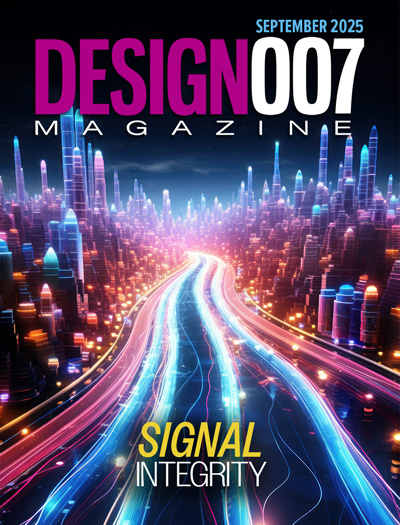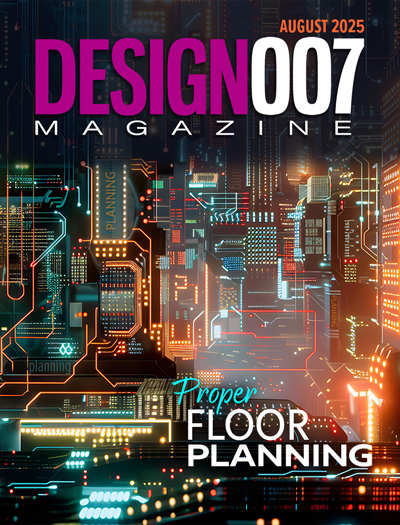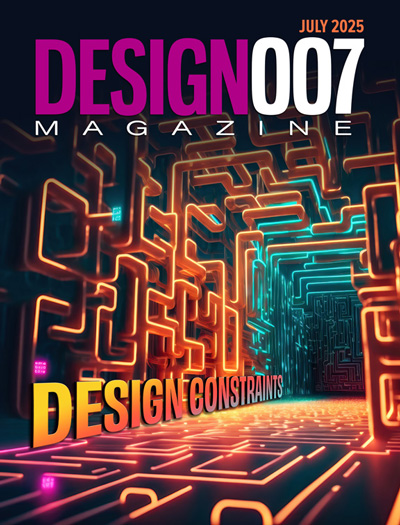-

- News
- Books
Featured Books
- design007 Magazine
Latest Issues
Current Issue
Signal Integrity
If you don’t have signal integrity problems now, you will eventually. This month, our expert contributors share a variety of SI techniques that can help designers avoid ground bounce, crosstalk, parasitic issues, and much more.

Proper Floor Planning
Floor planning decisions can make or break performance, manufacturability, and timelines. This month’s contributors weigh in with their best practices for proper floor planning and specific strategies to get it right.

Showing Some Constraint
A strong design constraint strategy carefully balances a wide range of electrical and manufacturing trade-offs. This month, we explore the key requirements, common challenges, and best practices behind building an effective constraint strategy.
- Articles
- Columns
- Links
- Media kit
||| MENU - design007 Magazine
Part 2: The Printed Electronics Roundtable
September 22, 2022 | Andy Shaughnessy, Design007 MagazineEstimated reading time: 3 minutes
We recently held a roundtable with a team of printed electronic circuit experts from companies that run the gamut: John Lee and Kevin Miller of Insulectro, Mike Wagner of Butler Technologies, Tom Bianchi of Eastprint, and John Voultos of Sheldahl Flexible Technologies.
In the first part of this roundtable, the team dispelled a variety of myths surrounding PEC. In this second part of the roundtable, the participants discuss what designers and fabricators need to know to jump into printed electronics, and some of the drivers behind this growing technology.
Andy Shaughnessy: We’ve looked at some of the myths about PEC. Now, how would a fabricator or PCB designer get involved in doing printed electronics? What resources are available? What’s the first step?
Tom Bianchi: Talk to Eastprint, Butler Technologies, or John at Sheldahl. That’s the first step.
Mike Wagner: Prior to the pandemic, one easy way was going to specific shows that had printed electronics as their theme. Eastprint was there and you could find the material suppliers they use, or Butler Technologies. You can talk to everybody—the material suppliers and the integrators—and come out of there with a whole set of suppliers to produce a product for you. You still have to seek those out. Sometimes, the shows are virtual, and others are going back to in-person, but I would get involved with those groups, whether it’s online forums or actual printed electronics shows, and you’ll meet the right crowd. That’s how I got involved—by going to these shows and networking at these events.
Kevin Miller: When I started in the printed electronics world, I’d spent 25 years in building and supporting the printed circuit boards industry. So, I did start bringing the technology to a few of the flex-rigid shops because there was some interest in it. We did some presentations showing the technology and manufacturing requirements.
A lot of the PCB manufacturers started out as screen printers as their process for inner layer and outer layer processing. They started with screens. Twenty to 30 years ago, you would go into a shop and there would be a screening room with 30 screeners in there because they didn’t have the dry film technology or the other processes. So, there was interest. Not to say that anybody has gone that route. I think they just understand it. There is some crossover between the two types of companies—printed electronics and printed circuit boards. We are seeing more interest in some of the additive processes that we can provide because it takes out many of the difficult process steps in building a printed circuit board.
Shaughnessy: But for a traditional PCB shop, what is the cost and steps of entry into PEC? What does that look like?
Miller: From my standpoint, you would start by hiring an individual who has spent many years working in a printed electronics facility. As far as capital equipment, they already have a lot of the equipment inside their printed circuit board shops. They all make their screens and put legend on the boards, so they have some of this equipment and understand it. It would be a more sophisticated screening process for the shop, and they would need to upgrade this process. Of course, there are needs like the big dryer. Also, the amount of dollars it would take to get into it would depend upon whether they wanted to build prototypes or volume. Of course, they would need to have the footprint available to expand.
Shaughnessy: Right. There are so many myths floating around about this, and we get asked, “How do I get involved with this?”
Miller: It’s not an easy process. It’s not like these guys just pick somebody off the street to run this place. There’s a lot of technology that you must learn and there are investments. They’re no different than the guys that have invested in printed circuit board shops. The biggest difference is that they’re probably not dealing with the plating chemistry and waste treatment that these circuit board guys are doing, because it’s all additive. I’m sure that there’s some of that, but it’s not like a PCB shop.
To read this entire conversation, which appeared in the September 2022 issue of Design007 Magazine, click here.
To read Part 1 of this conversation, which appeared in the August 2022 issue of Design007 Magazine, click here.
Testimonial
"Our marketing partnership with I-Connect007 is already delivering. Just a day after our press release went live, we received a direct inquiry about our updated products!"
Rachael Temple - AlltematedSuggested Items
Electrodeposited Copper Foils Market to Grow by $11.7 Billion Over 2025-2032
09/18/2025 | Globe NewswireThe global electrodeposited copper foils market is poised for dynamic growth, driven by the rising adoption in advanced electronics and renewable energy storage solutions.
Breakthrough in Non-Contact Solder Removal Earns Kurtz Ersa 2025 Mexico Technology Award at SMTA Guadalajara
09/18/2025 | Kurtz Ersa Inc.Kurtz Ersa Inc., a leading supplier of electronics production equipment, is proud to announce that it has been awarded a 2025 Mexico Technology Award in the category of Rework & Repair for its HR 600P Automatic Rework System.
A.R.T. Invests in Latest Equipment to Further Enhance Electronics Training Facilities
09/17/2025 | A.R.T. Ltd.Advanced Rework Technology Ltd. (A.R.T.), a leading independent IPC-accredited training provider, has announced a series of new equipment investments at its state-of-the-art training centre.
Richardson Electronics Appoints Daniel Albers to Drive Made-in-USA Contract Manufacturing Expansion
09/17/2025 | Globe NewswireRichardson Electronics, Ltd., a global provider of engineered solutions for the green energy, power management, and custom display markets, announced the appointment of Daniel Albers to spearhead business development for its expanded, Made-in-USA contract manufacturing efforts.
STMicroelectronics to Advance Next-generation Chip Manufacturing Technology with New PLP Pilot Line in Tours, France
09/17/2025 | STMicroelectronicsSTMicroelectronics, a global semiconductor leader serving customers across the spectrum of electronics applications, today announced new details regarding the development of the next generations of Panel-Level Packaging (PLP) technology through a pilot line in its Tours site, France, which is expected to be operational in Q3 2026.


